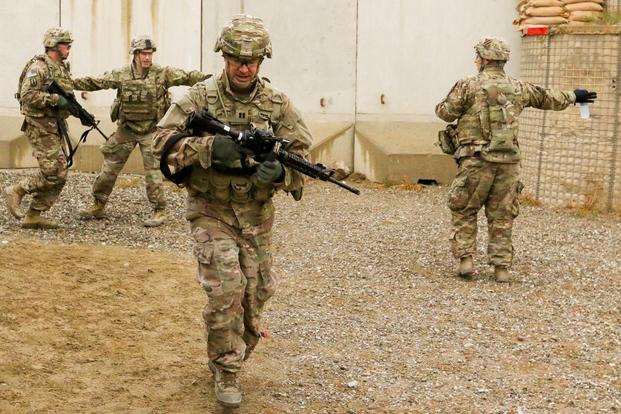More than 1,000 specially-trained U.S. advisors will go on offense with Afghan units at the battalion level in the spring under an ambitious plan to reverse Taliban gains and drive the insurgents to the bargaining table in two years, the U.S. commander in Afghanistan said Tuesday.
"Yes, there will be greater risk, absolutely" for the advisors now training at Fort Benning, Georgia, to serve in the new Security Force Assistance Brigades [SFAB] with the Afghans, said Army Gen. John Nicholson, commander of U.S.-Forces Afghanistan and the NATO Resolute Support mission.
Working as teams, the SFAB troops from all services will be involved in "combat advising at the tactical level, so they'll go down to the "Kandak" level, the battalion level" with units of the Afghan National Army and the Afghan Special Forces, Nicholson said in a video briefing from Kabul to the Pentagon.
"This will enable us to help the Afghans with their offensive operations simultaneously in multiple quarters" with the goal of gaining control of 80 percent of the population within two years and possibly forcing the Taliban into peace talks on ending the 16-year-old war, Nicholson said.
When the plan goes operational next spring, "you're looking at well over 1000 advisors out at any given time" with the Afghans, Nicholson said. "As we roll into the spring -- March/April -- they will go on the offensive. "
To limit risk, "we're going to great lengths to ensure force protection" with a "whole array of support behind them" to include overhead reconnaissance, ground and air fire support, and medevac availability when they go into the field, Nicholson said.
The plan to put advisors in the field grew out of President Donald Trump's Aug. 21 decision to switch to a "conditions-based" strategy in Afghanistan and authorize the deployment of at least 3,000 additional troops, Nicholson said.
Trump has acknowledged that he made the decision on the new strategy reluctantly and against his initial instinct, which was to withdraw U.S. forces completely.
Trump also reportedly wanted to sack Nicholson, but was talked out of it by Defense Secretary Jim Mattis and Joint Chiefs Chairman Gen. Joseph Dunford, a former commander of U.S. Forces-Afghanistan.
Nicholson has repeatedly said that the war was at a "stalemate,' but he called the new strategy a "game-changer," adding that "It's fair to say we're on a path to a win."
The Pentagon now says that there are 14,000 U.S. troops in Afghanistan, although a Defense Manpower Data Center report prepared in September and released earlier this month said there were 15,298 U.S. service members in Afghanistan.
With the additional forces, the U.S. is now committed to Afghanistan indefinitely, Nicholson said. "We will be here until the job is done." he said.
As he has previously, Nicholson took issue with reports from United Nations agencies, the U.S. Special Inspector General for Afghan Reconstruction [SIGAR] and think tanks which have portrayed a resilient Taliban increasingly well-funded by the booming poppy trade that supplies much of the world's heroin.
Nicholson said that the Taliban had given up on trying to seize provincial capitals and was now focused on guerilla warfare at the district level. He said that "represented a lowering of ambition by the enemy."
"Increasingly, they are principally interested in making money" from the drug trade, Nicholson. "They are fighting to protect their revenue stream" and have essentially transformed from a jihadi movement into a "narco-terrorist" drug cartel, he said.
Coupled with the new U.S. strategy, Afghan President Ashraf Ghani with coalition backing has embarked on revamping the entire command structure of the Afghan National Defense and Security Forces [ANDSF].
Ghani has replaced four of five corps commanders, Nicholson said, and next year will push 2,150 colonels and generals into retirement "with dignity" to allow a younger generation of officers to assume command.
To curb corruption in the Afghan forces, Nicholson said that the U.S. was initiating another round of identity verification to eliminate from the rolls so-called "ghost soldiers" -- those who draw salaries but are absent from the ranks.
The U.S. has tried biometrical data such as retinal scans and fingerprinting before, but Nicholson expressed confidence that the new effort would yield results to ensure that pay only goes to a "biometrically identified soldier."
Nicholson was less confident on receiving cooperation from Pakistan, which Trump has deemed as essential in carrying out the new strategy.
The Taliban still maintain well-known safe havens in the Quetta and Peshawar areas of Pakistan, Nicholson said, and fighters crossing from Pakistan provide recruits for the Islamic State offshoot known as Islamic State-Khorasan Province, or ISIS-K.
"We have been very direct and very clear with the Pakistanis" on curbing the Taliban, Nicholson said, but "we have not seen those changes implemented yet."
"We are hoping to see those changes, we are hoping to work together with the Pakistanis going forward to eliminate terrorists who are crossing" the border, Nicholson said.










